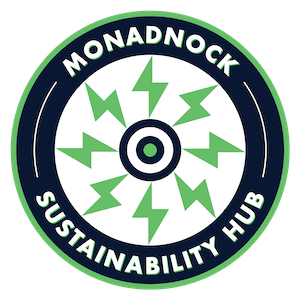By Catherine Owen Koning, Originally Published in The Monadnock Shopper News, Green Monadnock column, September 2025.
The lilacs in my yard have already lost their leaves, the hostas are wilting, and even some of the wetland plants look parched. The bean plants in my garden have dried out and stopped producing. The ground is dry as dust! The Monadnock region finds itself in a moderate drought, while other parts of New Hampshire are in severe or extreme drought conditions.
After a crazy wet spring, where May ranked as one of the wettest on record, it felt like someone turned off the sky sprinkler! New Hampshire and Vermont received only 33 percent of their normal August precipitation, and only 1.85 inches of rain fell in Keene in August, compared to an average of 4.5 inches. Some parts of the Monadnock region, such as Jaffrey and Rindge, got inundated with heavy rain a few weeks ago, but that band of storms bypassed Swanzey, Keene and other areas. When a lot of rain comes down suddenly, the ground is not able to absorb it, and it just runs off and contributed to flooding! In addition, when soil gets really dry, it becomes “hydrophobic,” meaning it actually repels water.
Why can’t we just have a good, steady, soaking rain? What is with these crazy flood/drought cycles? Sadly, it is all consistent with the predictions of climate change.
Air temperatures in New Hampshire have increased by an average of three degrees from 1901-2024, according to the NOAA National Climate Report. As the air temperature increases, warm air can hold more moisture, and it holds it for a longer time. When finally the air becomes oversaturated, then all that moisture comes down as heavy rainfall. Also, the dry, hot ground tends to give off heat which helps maintain the persistent high-pressure system that is responsible for the sunny, warm, dry and rainless weeks we have seen. So, dry conditions promote
more dry conditions.
Consequences of this wet-dry-flood cycle are enormous. Dry streams and warm water in larger rivers threaten cold-water fish species such as brook trout. Wildfire becomes more common, as the soils and forests dry out (those Canadian wildfires happened in forests much like ours in New Hampshire!). Even our fall foliage is less vibrant.
In moderate drought, shallow wells may go dry, in severe drought, even deep bedrock wells can fail. Some towns, such as Lebanon, have put water use restrictions in place.
Most New England farmers do not have the luxury of irrigation, and so vegetable and hay crops are reduced, and some farmers having to haul water for livestock. Livestock farmers have to buy expensive feed or buy hay from others. This is creating real financial worries for many of our local food producers.
Most of us can just turn on the tap and get the water we need, but we need to be mindful that all of our wells are just straws sipping from the same pot of water underground. We can start conserving water, by not washing cars or filling pools, not leaving the tap running when dishwashing, etc. We can also reduce the amount of asphalt and concrete on our property, so when it does rain, it can soak in. Keeping shade on the edges of our streams and lakes helps the aquatic life stay cool, too.
The most important step we can take to reduce the risk of future droughts and floods is to slow down climate change. Use less gas, oil, and burn less wood. Make your home energy-efficient. Convert your home to clean energy, by signing up for Community Power in your town and opting up to 100 percent renewable energy. Or, join the solar revolution – solar panel installations increased by 64 percent this year. Electrify your heating and cooling system with “mini-splits” or heat pumps – we just got one this year, and we would not have survived the heat wave without it! To learn about all this and more, come to the Monadnock Clean Energy Fair on September 27 from 10 a.m. to 2 p.m. at the Peterborough Elementary School, for kid’s activities, music, food, and clean energy workshops and vendors. Learn what you can do!
Catherine Owen Koning is a Professor of Environmental Science at Franklin Pierce University, where she co-coordinates the Institute for Climate Action. She is also a member of the Monadnock Sustainability Hub’s Board of Directors and co-chairs the Keene Clean Energy Team.
